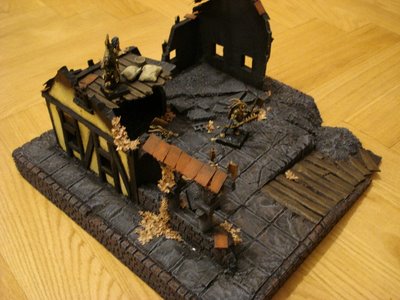Dec 28
Adding Bases to Terrain
Since my last post about adding bases to buildings, I’ve done a lot of thinking about it. I’ve compiled more points, and put them below:
Good Things About Using a Base on Your Buildings and Terrain:
- Stability: With a base, you don’t even have to worry about the stability of your large building. Just glue it down.
- Debris and Junk: It makes it very easy to add debris and fallen pieces of terrain around the building as you can just glue it to the floor. You don’t have to worry about connecting it to the building for support. This also includes objects like Tombstones, light poles, etc.
- Creating Elevation: This is the most practical use of a base, and one of the only reasons I would use a base. Using bases to create elevation is a great idea, although I wouldn’t really consider that using a base. When a base creates elevation, it becomes part of the terrain, . Here’s a great example of a beautiful piece of elevation. This was created by Tom from Tom’s Boring Mordheim Blog:

Bad Things About Using a Base on Your Buildings and Terrain:
- Lip/edge: When you add a base to the bottom of a piece of terrain, you end up with that small lip which (depending on what you use for a base) can be enough to prevent a model from resting on it. So you have to change where you were putting your model… (This is a small picky thing that annoyed me to no end at a friend’s house.)
- Proximity: It also prevents terrain from being placed close together. And some scenarios like “Street Fight” require that.
- Existing Elevation: Bases also prevent you from using hills on your table. If you look at the terrain in the middle of the image below, you will see that because of the two hills on either side of the building, it isn’t actually flat on the table; it is raised about a cm. It would have fit perfectly without a base.
- Storage and Travel: Along the same lines of the Proximity note: When you’re trying to fit all your terrain into one box, having those wide bases prevents you from compacting your buildings close together.
- Color Schemes: When you have a base, you must texture it to look like the board you play on. You need to make it “camouflage” with the board you play on. So if you have a brown board with sand, your base will need to stick to that color scheme. The problem is with the future. What if you make a new board with a different pattern? go to a friends house with a different colored board completely? Then it will look like this (which, by the way, is ugly):
To conclude:
The only time I will add a base to my building is to create elevation or to add to the terrain. It really is not too difficult to add stability to large buildings made from foam and Popsicle sticks. It does take some extra work to add the stability and debris, but with everything considered I think it creates a much more professional building, and after working so hard to make it aesthetically pleasing I want it to always be that way, no matter who’s board I play on.
I will also note that I’m not blindly against bases. =) When I make my graveyard, I will definitely use a square base, and hide the lips by making it a part of the outlining wall. Since it’s a graveyard, the dirt can be a different color, and this will make it easy to have tombstones and piles of dirt, graves, coffins, etc. spaced however I want it, and all the points above will be covered.
That concludes my tips on adding bases to buildings.
Ashton Sanders
